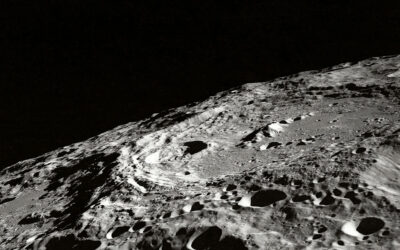A new theoretical study is challenging long-standing assumptions about how the universe expanded in its earliest moments. Researchers have found that subtle interactions between particles known as inflatons — which make up the inflation field believed to have driven the universe’s rapid early expansion — can influence the fluctuations in that field, potentially affecting predictions about the structure of the cosmos, the formation of primordial black holes, and the nature of dark matter.
“We found that in scenarios where quantum fluctuations grow large — especially those leading to observable gravitational wave signals — standard analytical methods miss important effects,” Angelo Caravano, a postdoctoral researcher at the Institut d’Astrophysique de Paris and one of the authors of the study, said in an email. “One key effect is backreaction, which means that the fluctuations don’t just passively evolve — they actually feed back into and alter the overall evolution of the universe.”
“This changes both the duration of inflation and the predicted signals we might observe. Our study shows that properly accounting for these effects is essential for making reliable predictions that can be tested by future experiments.”
The engine of inflation
According to prevailing cosmological theory, the universe underwent an explosive growth spurt a tiny fraction of a second after the Big Bang. This inflationary phase caused space to stretch exponentially, smoothing out any initial wrinkles in its geometry and creating the seeds for the galaxies we see today.
“Observations of the early universe, such as those from the cosmic microwave background — the faint electromagnetic afterglow of the Big Bang — are well explained by inflation,” Angelo Caravano, a postdoctoral researcher at the Institut d’Astrophysique de Paris and one of the authors of the study, said in an email. “In this model, a new field beyond the standard model of particle physics — called the inflaton — drives the expansion.”
This straightforward framework accounts for key features of the cosmic microwave background, including its minute temperature fluctuations — on the order of one part in 100,000.
Like photons in the electromagnetic field, inflatons make up the inflationary field, but they’ve never been directly observed. That leaves researchers relying on theoretical models to understand their properties and the role they played in shaping the cosmos.
Why inflaton self-interactions matter
Traditionally, most models assume that inflatons do not interact with each other strongly, or that their self-interactions have negligible effects on the evolution of the universe, as similar approximations are often valid in many physical scenarios and greatly simplifies calculations. This simplification has allowed theorists to build tractable models of inflation and make predictions that reasonably match observations of the cosmic microwave background.
But the new study published in Physical Review D suggests that this assumption may not always hold — especially when considering phenomena like the birth of primordial black holes or the generation of gravitational waves in the early universe.
In the lattice approach used by the authors, spacetime is modeled as a discrete grid rather than the smooth continuum it appears to be in reality. This simplification makes reliable calculations possible, as studying inflation in truly continuous space is computationally intractable.
“Simulating inflation on a lattice is a recent breakthrough in theoretical cosmology, enabling the study of inflation beyond standard approximations and capturing nonlinear effects that analytic methods cannot fully address,” explained Caravano. “Rather than relying on equations valid only for small fluctuations, we simulate the full nonlinear dynamics on a computer. This allows us to track how the system evolves when quantum fluctuations become strong enough to alter the course of inflation itself.”
Their simulations showed that in several realistic models of inflation, the absence of self-interactions is not a good approximation, as such interactions can substantially alter the size of matter inhomogeneities in the early universe compared to what interaction-free approximation predicts. These fluctuations play a central role in determining where matter clumps together, and under the right conditions, can collapse into black holes shortly after inflation ends.
Black hole seeds and dark matter clues
The findings suggest that self-interactions can either boost or reduce the formation of primordial black holes — hypothetical objects thought to have emerged from sharp density fluctuations in the early universe. Since these black holes are considered a promising, though still speculative, explanation for both dark matter and the origins of supermassive black holes at the centers of galaxies, incorporating the self-interaction effects uncovered by the team is crucial for advancing research on these major open questions in fundamental physics.
If self-interactions of inflatons did indeed influence the scale of matter density fluctuations in the early universe, they may have also played a role in shaping the large-scale structure of the universe as galaxies and galaxy clusters, which we observe today, are believed to have formed from these fluctuations as the universe evolved. That makes understanding these effects not just a theoretical curiosity but a critical part of explaining the universe’s evolution.
Toward testable predictions
The team say they plan to improve the precision of their simulations and apply their method to a broader range of inflationary models. A key goal is to examine how inflaton self-interactions might influence the spectrum of primordial gravitational waves — subtle ripples in spacetime that future detectors may be able to capture.
“One of the most exciting predictions of inflation is a burst of gravitational waves in a frequency range that will be probed by future space-based observatories like LISA, a European Space Agency mission scheduled for launch in 2035,” said Caravano. “If LISA or similar experiments detect such a signal, it would be a major clue about what happened in the early universe.”
These waves could serve as a powerful probe of the inflationary era, offering a way to distinguish between competing models and uncover new physics from the earliest times.
“This study focused on revealing where standard methods fall short, especially in capturing the full dynamics of the inflaton field. The next step is to use our simulations to compute observable quantities — like the precise gravitational wave signal — directly,” said Caravano. “Our goal is to make these tools publicly available so the broader research community can use them to test inflationary models against upcoming data. We’re actively working on this and plan to release a follow-up study soon.”
Reference: Angelo Caravano, Gabriele Franciolini, and Sébastien Renaux-Petel, Ultra-Slow-Roll Inflation on the Lattice: Backreaction and Nonlinear Effects, Physical Review D (2025). DOI: 10.1103/PhysRevD.111.063518
Feature image credit: Melmak on Pixabay

















